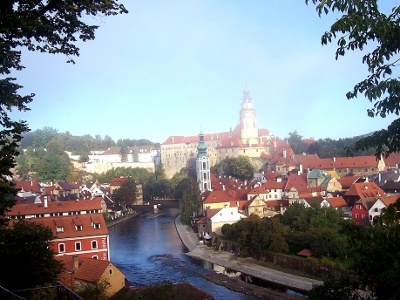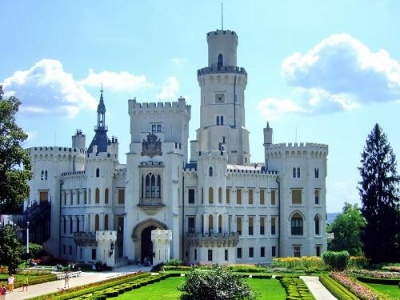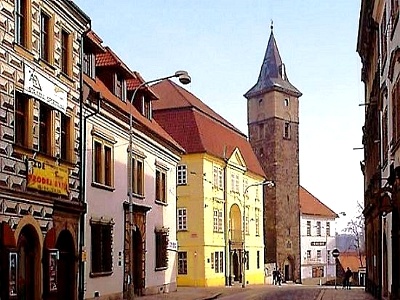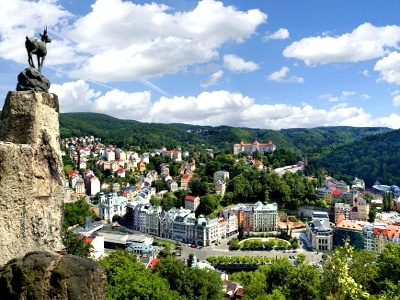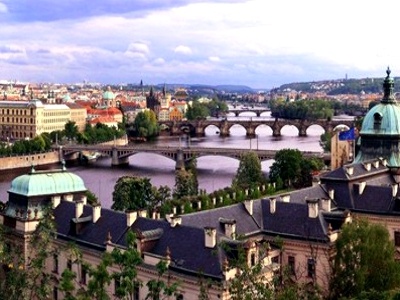 |
|
|
|
Czechia – Queen of Hearts
01.10.2010 — Analysis This autumn my long-time dream came true. I spent a week in Czechia, and though my visit was short, I was able to see this wonderful country in its all diversity. Owing to the Czech Tourism National Department, which opened its representative offices first in Moscow and later, this spring, in Ekaterinburg, "the right to life" has become available to new destinations that can impress even most experienced tourists. The trip that a group of Ural journalists made around the ancient land of Bohemia is a convincing proof of this. Fabulous town of the Renaissance – Krumlov The very first minutes we arrived in Český Krumlov, I plunged into guesses – what century did I step into? "The construction of Krumlov began in the 13th century, at the intersection of important trade routes, – our guide Irena says. – The town is located 180 kilometers from Prague, close to the Austrian and German borders in the area of South Bohemia. Český Krumlov Castle built on the rock ranks among the most beautiful and largest castles in the Central European region". No description can convey the singularity and enchantment of the town where the time stands still. No wonder that Český Krumlov is the largest historical reserve of UNESCO. Even the main river of Czechia – Vltava flows here in a special way. With its three meanders it three times approaches the downtown. The town viewed from a high hill reminds Venice that is also divided into two parts by the Grand Canal. How fascinating it is walking along narrow streets of Krumlov, breathing in the delicious aroma of meat roasted on open fire, the aroma that intermingles with wonderful scents of wine, cinnamon, and freshly baked pastries. You can drop in a medieval tavern where old traditions are still kept, and then visit museums enjoying their rich collections or head for miscellaneous gift and craft shops. Each street and, may be, each building in Krumlov has its own story, sometimes more than one. Not only guides, but also citizens will be glad to share them with you.
Passions around Hluboká The town of Hluboká in South Czechia prides itself on the castle built in the 13th century – the most romantic and picturesque castle not only in Czechia, but also in Western Europe. It is hard to believe, but within the first 400 years of its life, the castle had changed 26 owners who had to dispose of the castle as compensation fee for a royal rabbit shot at an unfortunate time or as pay-off to cover their debts. Only when it came into possession of the rich and dignified family of Schwarzenberg, one of the descendants of which was Karel Schwarzenberg, Minister of Foreign Affairs of Czechia in 2007-2009, the castle acquired its present dazzling appearance. Magic Venetian mirrors, fascinating wood carvings, 12 thousand books in five languages, and most valuable collections of Flemish tapestries and medieval weaponry.
If you want to know Czechia, go to Písek Just like Russia cannot be judged by Moscow, so Czechia cannot be judged by Prague. I, together with many others who know this European country only from movies and books, was wrong being confident that Karlov Bridge built in Prague in the 14th century is the oldest in Czechia. It turned out that Stone Bridge across the Otava River in the town of Písek (means “sand” in Russian) was 500 years older. Moreover, the Písek bridge decorated with sculptures in the 17th century is the second oldest structure in Europe, yielding only to the bridge in Regensburg, Germany. This town located in South Czechia owes its name to coastal sand: people used to find gold there in the Middle Ages. Gold deposits depleted long ago, but today Písek is famous for international festivals of giant sand sculptures. "The town is justly called Athens of South Czechia due to its intensive cultural life", - Irena points out. Like any other self-respecting Czech town, it has an ancient castle. I was happy to visit an interesting museum built at the site of the first hydro power plant and to feast my eyes on old ecclesiastical and civil architecture. I got slightly envious seeing that modern buildings are not only eye-catching, but are in perfect fit with old historical surroundings, without damaging the medieval appearance of the town. Such harmony is typical of all the Czech towns and cities.
Subterranean labyrinths of beery Plzen Czech kings must have been far-sighted and wise people. It was in 1307 when Plzen citizens were granted the right to brew beer. "Today, quality of our liquid bread is checked in laboratories. Previously, a person put on leather pants, poured beer on a bench and sat on it. If the bench stuck to his pants, the beer was of excellent quality", – says Irena. However, Plzensky Prazdroj is not the only attraction in Plzen – a large industrial, cultural and administrative center of Western Bohemia, the city of the St. Bartholomew’s Cathedral with the 103-meter high bell-tower, the tallest tower in Czechia. Here is one of the main Czech relics – the Plzen Madonna. The legend says that it was made by a blind artist who recovered his sight after he finished his work. In the 16th century, for its faithfulness to the Catholic Church, under the mandate of Pope Paul II, Plzen was granted the right to adorn its coat-of-arms with the pattern of two keys and a knight. Although the city has no subway, you still can visit its "underground". Plzen is famous for its catacombs remained from the 13th century. The catacombs are quite casual: no holy relics were buried and no prisoners were locked in them. The Plzen underground was used first of all as storage space for water reserves, and on special occasions it was used as shelter to rescue people from hostile invasions. The brick and stone lined underground galleries have quite friendly appearance. Out of almost 25 kilometers of labyrinths, only 800 meters are available to tourists; however, even this is enough to get an idea about ancient subterranean networks of European cities.
13th spring of Karlovy Vary The Tepla River surrounded by fabulous mountains flows quietly along a deep valley in Western Czechia. The famous resort Karlovy Vary founded approximately in 1350 is located on its shore. During one weekend, representatives of wealthy European aristocracy can leave in local restaurants, health centers and stores 20 million korunas. The Czechs do not mind this: tourism ranks second in the revenue to the national budget, yielding only to machinery manufacturing. However, Karlovy Vary is notable not only for excellent health facilities, but also for its savory food and versatile attractions. It was here that in 1857 the manufacturing of Moser royal crystal came to life. "I wish Karlovy Vary were as important for Czechia as Sèvres for Paris and Murano for Venice" — those were the words describing the mission set for himself by Ludwig Moser, the founder of the factory and the artist who discovered the formula, due to which glass receives a clear sound and can refract light without lead additives. The new technology turned out to be a golden opportunity for glass-blowers and carving artists who could show their skills to the full extent: Moser crystal glass is light and suitable for very fine engraving. Within its entire life up to our days, the factory uses manual manufacturing, which you can see with your own eyes. One of the most famous sets known as "Splendid" was made by the factory craftspeople in 1911. Its shapes match the golden section proportions. In 1947, 178 items of the Splendid set were presented to Elisabeth II, then the future queen of Great Britain, as a gift for her wedding. 60 years later, Czech President Václav Klaus presented another few Moser goblets to Elizabeth. Karlovy Vary Spring No. 13 is the name given by the Czechs to their renowned Becherovka factory. For those who do not know: in Karlovy Vary there are 12 mineral springs that are used for drinking and other medical treatments. Becherovka liqueur is made using more than 20 herbs under the technology that has remained unchanged since 1807; the liqueur should be taken in small amounts and from small glasses. It will help digestion, if the local mineral water has failed to do it…
Mariánské Lázně’s main attraction is in its recollections Sitting on a bench in a wonderful park intertwining with forests surrounding the city, I was trying to solve an enigma of Mariánské Lázně aristocratic resort located fifty kilometers from Karlovy Vary. Why did it happen so that the Russian writer Ivan Goncharov was able to find his muse here after having lost it and to finish his Oblomov, according to the memorial plaque on the Grandhotel Pacific? The local theater is named after Nikolay Gogol who was rewriting his "Dead Souls" here in 1839. The memorial plaque in the Maxim Hotel asserts that it was there that Gorky, another Russian writer, was thinking sadly about tough life of Russian working people. Though, no one knows what exactly he was thinking about while relaxing in a tub filled with mineral water and sipping Rhine wine from a glass... It is known for certain that it was in this amazing town that seventy-year-old Goethe fell in love with seventeen year old Ulrike Levetzow. And 100 years ago, the American inventor Thomas Alva Edison said: "There is no other resort in the world that could be more beautiful". In the old days, Mariánské Lázně was a favorite resort for Russian aristocracy. Even Emperor Alexander III visited this town. No wonder that for more than one hundred years the town has been adorned with the orthodox St. Vladimir’s Cathedral. It has the world’s only porcelain iconostasis made by Russian craftsmen and decorated with cobalt and gold. In 1900, it was awarded the Grand prix de Paris. Tranquility of forests, beauty of parks, magnificent architectural mosaics and pristine air have not lost their charm today. Mysterious depths of the Slavkov Forest give birth to sparkling healing springs. In contrast to the Karlovy Vary hot springs (37-73°C), the local springs are cold and not very deep. Near the Cross Spring there is a singing fountain – every odd hour the water dance is accompanied with music, and later at night the crescendo reaches its top intensity enhanced with dazzling illumination. 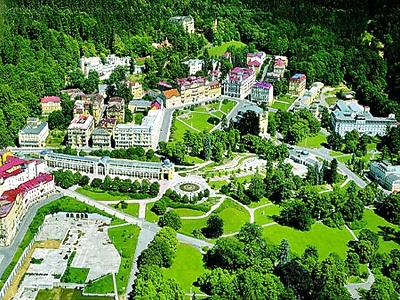 Spellbound by Prague "I am longing for Prague, – wrote Marina Tsvetaeva. – Never in my life have I wanted to come back to any city, but I do want to go to Prague!"
The desire of the great Russian poetess is quite understandable. Prague is a delightful city where you breathe easily and your heart sings. I was walking all day long around the city and felt no tiredness. Not without a reason the Czech capital is known as Northern Rome. Picturesque parks, diverse architectural styles, affluent Vltava River… Steeples, cupolas of old churches and castles are looking out from everywhere. The town of Prague founded late in the 9th century as the symbol of the political power of Czechia served at first as the permanent residence for Czech kings, and starting from 1918 – for presidents of the republic. Add to this the residence of the Archbishop of Prague, tombs of Bohemian kings and repository of crown jewels – Saint Vitus Cathedral, the construction of which took the time that was record long even for haste-free building history of European cathedrals – from 1344 to 1929. You can follow my example and have a few minutes of laugh in the center of Prague, when suddenly you come across… a monument to ghost neighboring the city hall building. So these are Czechs – unhurried, reserved and full of dignity. At the same time, they are the true people of the good soldier Schweik – cheerful, and merry, loving beer, delicious and satisfying meal, which is offered everywhere both in Prague and other cities. As for me, I developed a craving for "svíčková na smetaně" – beef sirloin served with special cream sauce garnished with dumplings. As with most of traditional dishes, this one has such a variety of recipes that it can be compared only with the number of cooks in Czechia. Czechia has always been a proud Slavic beauty that enchants and captivates a Teutonic knight. The country that is unbelievably rich in sights. Just imagine, there are more than 2,500 castles in this quite a compact country. The Czech anthem has the words "paradise on earth it is to see…". Hit the road, and check yourself! Natalia Gorbacheva |
| Regions | Project participants | Investment projects | Consulates and Trade Offices | News and Analysis | About the Project |
|
© RusBusinessNews, 2009. All rights reserved. Establishing a hyperlink to RIA RusBusinessNews is required for using any of the material published on this website. News and analytical reviews are translated into foreign languages by the TRANSLIT Translation Agency |
«Sum of technologies»® Web design Site promotion |
